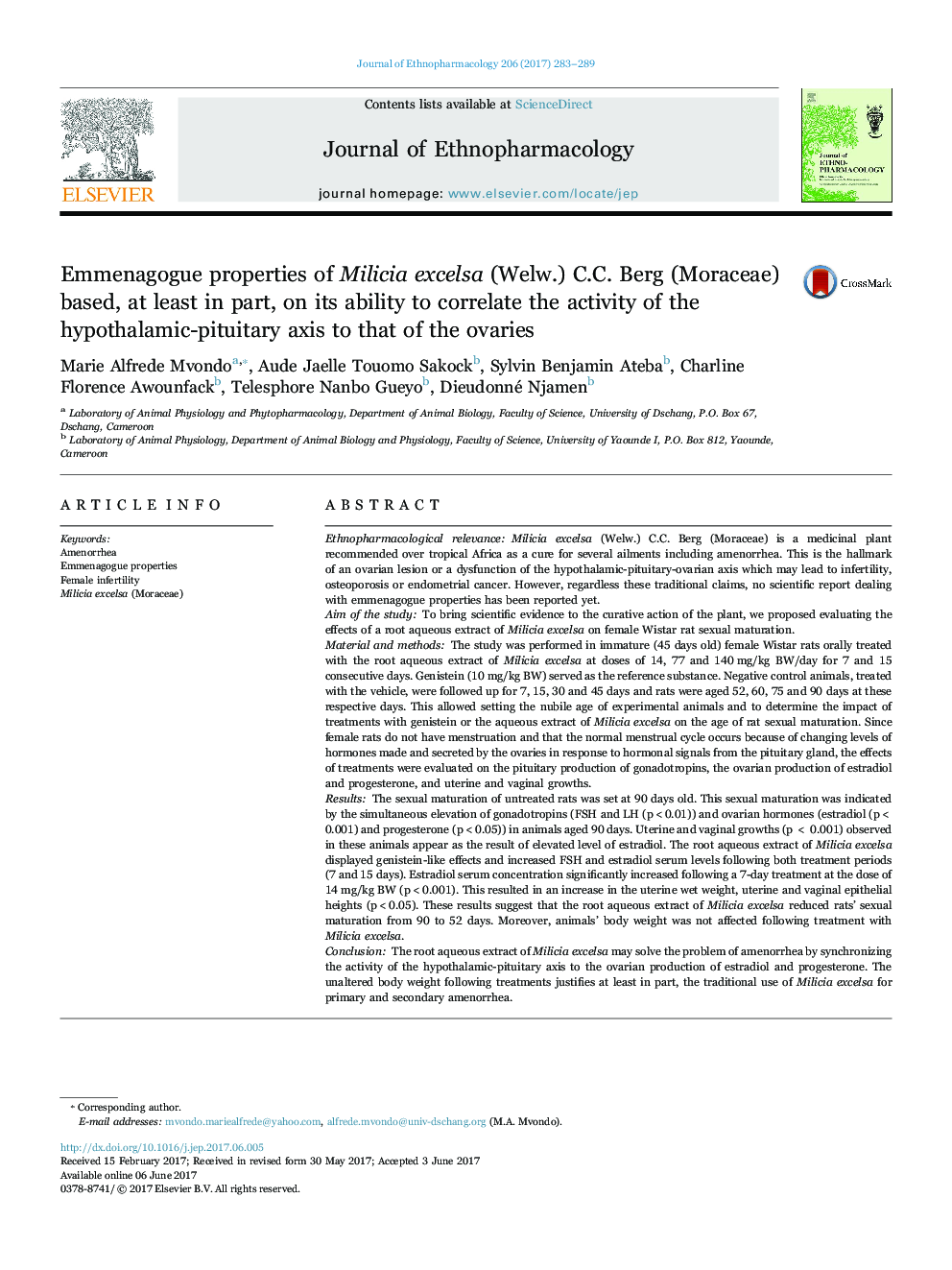| کد مقاله | کد نشریه | سال انتشار | مقاله انگلیسی | نسخه تمام متن |
|---|---|---|---|---|
| 5556214 | 1560356 | 2017 | 7 صفحه PDF | دانلود رایگان |

Ethnopharmacological relevanceMilicia excelsa (Welw.) C.C. Berg (Moraceae) is a medicinal plant recommended over tropical Africa as a cure for several ailments including amenorrhea. This is the hallmark of an ovarian lesion or a dysfunction of the hypothalamic-pituitary-ovarian axis which may lead to infertility, osteoporosis or endometrial cancer. However, regardless these traditional claims, no scientific report dealing with emmenagogue properties has been reported yet.Aim of the studyTo bring scientific evidence to the curative action of the plant, we proposed evaluating the effects of a root aqueous extract of Milicia excelsa on female Wistar rat sexual maturation.Material and methodsThe study was performed in immature (45 days old) female Wistar rats orally treated with the root aqueous extract of Milicia excelsa at doses of 14, 77 and 140Â mg/kg BW/day for 7 and 15 consecutive days. Genistein (10Â mg/kg BW) served as the reference substance. Negative control animals, treated with the vehicle, were followed up for 7, 15, 30 and 45 days and rats were aged 52, 60, 75 and 90 days at these respective days. This allowed setting the nubile age of experimental animals and to determine the impact of treatments with genistein or the aqueous extract of Milicia excelsa on the age of rat sexual maturation. Since female rats do not have menstruation and that the normal menstrual cycle occurs because of changing levels of hormones made and secreted by the ovaries in response to hormonal signals from the pituitary gland, the effects of treatments were evaluated on the pituitary production of gonadotropins, the ovarian production of estradiol and progesterone, and uterine and vaginal growths.ResultsThe sexual maturation of untreated rats was set at 90 days old. This sexual maturation was indicated by the simultaneous elevation of gonadotropins (FSH and LH (p<0.01)) and ovarian hormones (estradiol (p<0.001) and progesterone (p<0.05)) in animals aged 90 days. Uterine and vaginal growths (p < 0.001) observed in these animals appear as the result of elevated level of estradiol. The root aqueous extract of Milicia excelsa displayed genistein-like effects and increased FSH and estradiol serum levels following both treatment periods (7 and 15 days). Estradiol serum concentration significantly increased following a 7-day treatment at the dose of 14Â mg/kg BW (p<0.001). This resulted in an increase in the uterine wet weight, uterine and vaginal epithelial heights (p<0.05). These results suggest that the root aqueous extract of Milicia excelsa reduced rats' sexual maturation from 90 to 52 days. Moreover, animals' body weight was not affected following treatment with Milicia excelsa.ConclusionThe root aqueous extract of Milicia excelsa may solve the problem of amenorrhea by synchronizing the activity of the hypothalamic-pituitary axis to the ovarian production of estradiol and progesterone. The unaltered body weight following treatments justifies at least in part, the traditional use of Milicia excelsa for primary and secondary amenorrhea.
The root aqueous extract of Milicia excelsa (Moraceae) may solve the problem of amenorrhea by synchronizing the activity of the hypothalamo-pituitary axis to the ovarian production of estradiol and progesterone.200
Journal: Journal of Ethnopharmacology - Volume 206, 12 July 2017, Pages 283-289